The secrets and legends of Holly
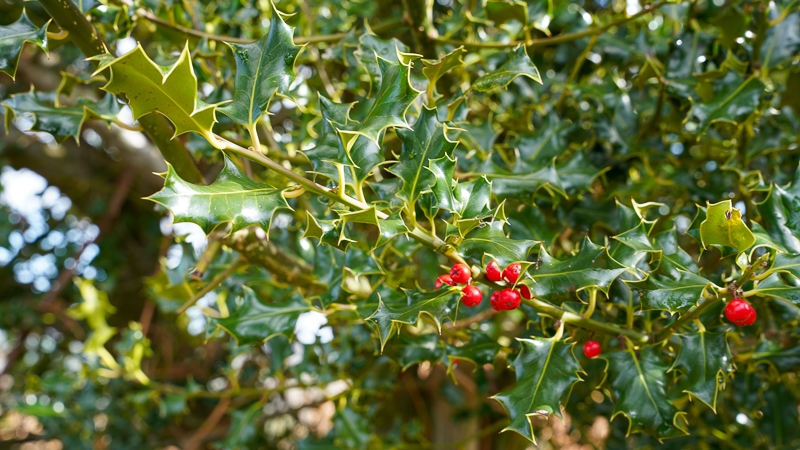
Holly has been our companion for a very long time. In fact, fossil records show Holly lived with the dinosaurs too, at least as far back as the Cretaceous Period, over a hundred million years ago.
A charming book called The Pageant of Nature, from 1923, tells us "Holly has always stood for mystery and plant personality." This remains true. Holly is strong, stubborn and enigmatic. Perhaps a strength drawn from living with dinosaurs, or simply from watching millennia pass by.
My favourite things about Holly are secrets and legends.
There's one secret, in particular, that Holly still keeps from us. Why are some Holly leaves smooth, and others spiky?

mixed spiky and smooth Holly leaves near the ground
Some naturalists will tell you it's because Holly produces spiky leaves low down, where animals might eat them, and smooth leaves up high, where spiny protection isn't needed.
This idea has been around for at least a century. The Pageant of Nature says Holly leaves are spiky within 12 ft of the ground, behaving "as if it knew that at that height it was free from the attacks of browsing animals."
A 2013 study found that browsed Holly (munched by animals) had a higher proportion of branchlets with spiky leaves, and the higher the Holly's bottom (lowest branches) off the ground, the less likely Holly was to be browsed and the lower the proportion of spiky leaves. The study links this correlation to epigenetics (genes changing in response to environment).
Reasonably compelling evidence that Holly adjusts her leaf spikiness according to whether the leaves are being chewed by passing mammals, then. But the study was only based on 40 trees, and didn't look at proportion of spiky leaves by height; it only linked height of the lowest branches to likelihood of browsing and overall proportion of spikiness. The authors acknowledge how little we know about leaves changing in response to environmental factors.
Hollies changing the way their genes work in response to browsing is fascinating, but I won't delve into the handful of other studies on Holly spikiness because they don't explain the living experience of our Hollies.
There are so many Hollies near me. Unsurprising, given Holly is our most common evergreen. There are Hollies high on the exposed moor, low in ancient woodland, tumbling over garden walls and prickling graveyards all around.
And as anyone who sees a lot of Holly will tell you, many of them don't care for our theory that leaf spikiness is correlated with browsing height.
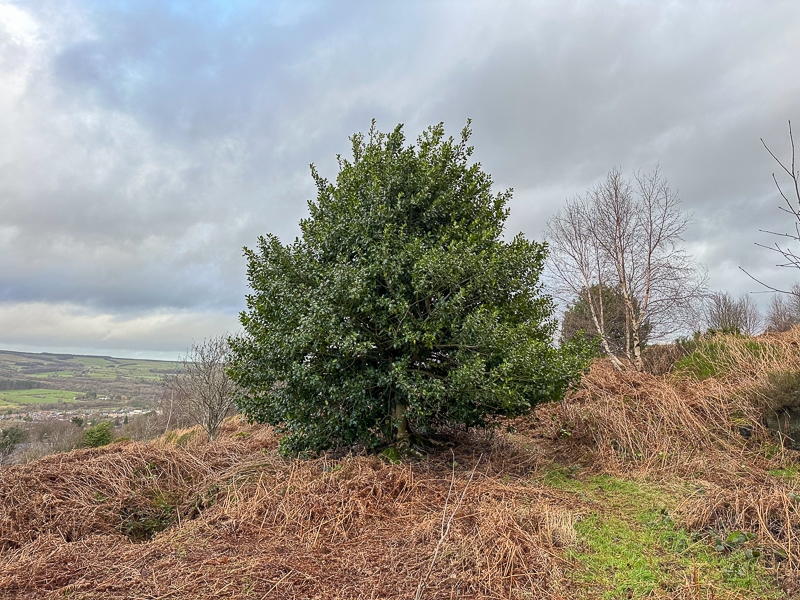
a big Holly, with branches close to the ground, and only smooth leaves
I know Hollies towering over 15 ft, with branches almost brushing the ground, who are entirely smooth-leaved. Others are tall and spiky all over, well above the browsing reach of any animals here today.

a towering Holly, spiky all the way to the sky
Yet more are a mix: spiky and smooth leaves at all heights, growing alongside each other.
The fun fact that Hollies have spiky leaves below the browsing height of deer (our tallest browsers) and smooth leaves above is a generalisation that often doesn't play out.
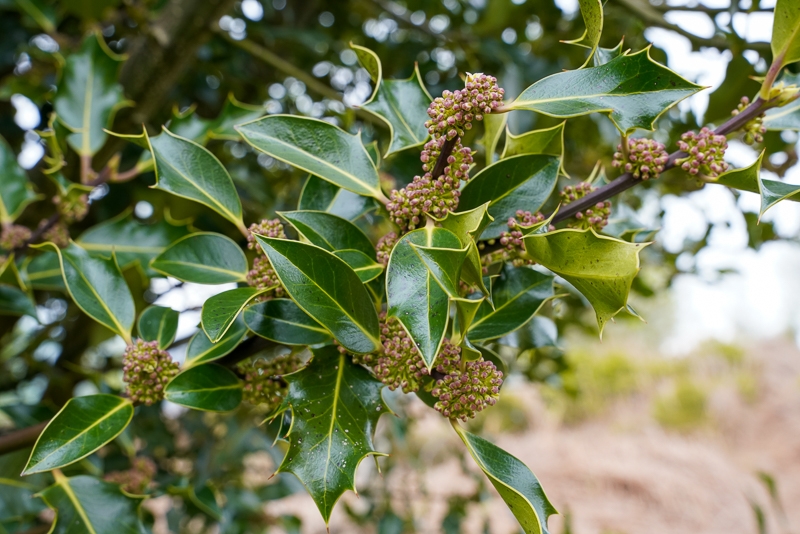
spiky and smooth Holly leaves growing together, close to the ground
The truth is much more interesting: we have very little idea how or why Holly grows her leaves smooth or spiky.
Fiona Stafford writes that some Hollies have smoother leaves in maturity, particularly high up, leading people to regard Holly as an emblem of mellowing with age.

a mellow matriarch?
Archie Miles wonders if smooth-leaved Hollies are a crossing with a spineless cultivar (a variety selectively bred by humans), but that's an unlikely explanation for Hollies far up the moor, whose sisters have plenty of spikes.
In The Nature Book, 1913, we find a summary still true today: the noticeable tendency for Holly leaves to be smooth on higher branches "cannot, from the evidence afforded by our native Hollies, be defined as more than a tendency."
For the naturalists still convinced of the simplistic theory that Hollies have spiky leaves below deer-browsing level, I present to you this Holly, growing easily 25 ft high in the comforting arms of a Plane tree, and spiky all over.
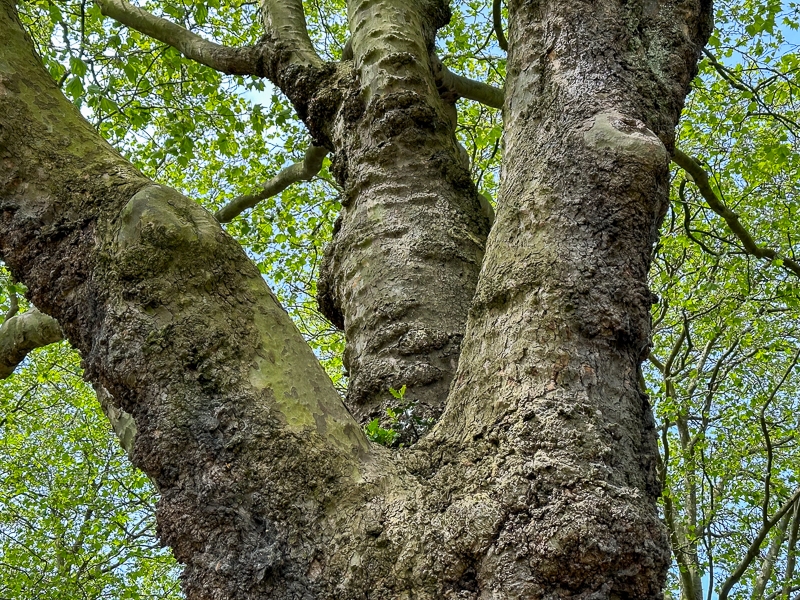
Maybe squirrels nibble Holly too, and that's why the spread of spiky and smooth leaves is much more varied than the deer theory suggests.
Perhaps the towering, spiky-all-over Hollies have a long memory, protecting themselves from nibbling by long-necked Pelorosaurs from the early Cretaceous.
Maybe Hollies with smooth leaves brushing the ground know the spikes of a Holly leaf are no defence against deer, so don't bother growing them.
Or there could be other factors at play. Nutrition might determine whether Holly grows her leaves spiky or smooth, or exposure, weather, access to water. Maybe just good old fashioned individual variety.
In all likelihood, a hugely complex set of historical, genetic, environmental and individualistic factors make up the pattern of smooth and spiky leaves on any Holly at any time.
We should find fascination in the tendency for Holly to be spiky low down and smooth up high but not treat our recognition of it as evidence that we fully understand Holly's secrets.
Western science's clinical, mechanistic approach has been leeching into public perception of the natural world for centuries. The false dividing line between humans and other species, and the superiority that comes with it, particularly the myth that we know, or will soon know, all there is to know about how other species operate, interferes with our connection to the species we share our planet with.
Let's find ways to rejoice in the incredible abilities uncovered by scientific studies while continuing to acknowledge how little we know. We shouldn't neglect real-world experience of living species for generalisations from correlative studies. While there are still gaps in our knowledge (and there always will be), we should embrace a little magic and mystery.
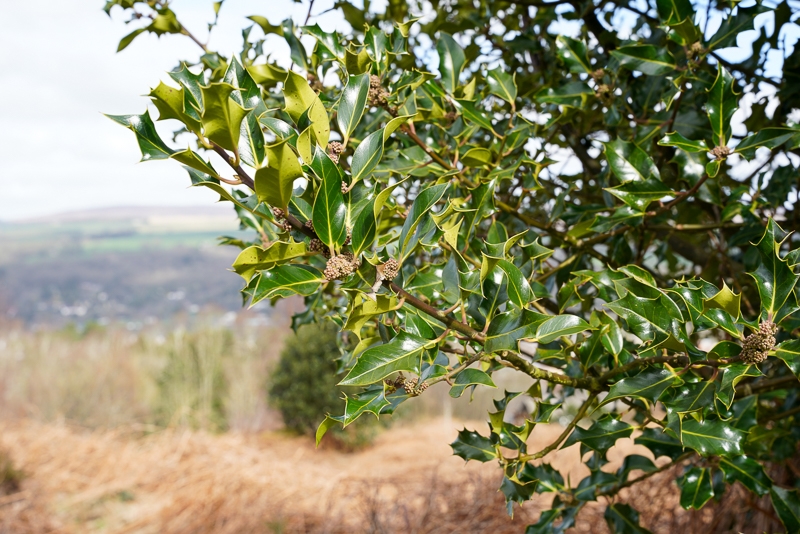
And what of the legends Holly holds?
Holly has been loved as a tree of good luck and protection for centuries. A sturdy companion, if you wrong Holly by cutting a tree down, you'll suffer a death in the family, so the legend goes. If you see a field with a lone Holly where a hedgerow might've been, she was probably left to avoid bad luck.
Holly has joined us for festivities for a long time, too. The Romans used to decorate with Laurel, Holly, and Bay to celebrate Saturnalia (17th-23rd December), a holiday honouring the old Earth god, Saturn.
Holly is also part of Pagan festivals at this time of year. The Holly King rules the winter months, having taken over from the Oak King at Samhaine (31st October). Holly will reign supreme until May Eve (30th April), when the Holly King will lose the hand of the Maiden to the Oak King, who will rule the summer months while Holly returns to the Wild Wood until winter.
Later, Christianity co-opted Holly as symbolising Jesus's crown of thorns, the berries drops of Christ's blood (rather macabre for a jolly symbol we bring into our homes, but the macabre is a centrepiece of Christianity).

Later again, concerns about demons and women led to increased fear of witchcraft, and Holly became a defender and saviour. Legend has it that a spiky Holly hedge protects a house from witches and storms. In Buckinghamshire, people were loathe to cut down Holly lest she release the witches she'd trapped, and in East Sussex some hedgerow Hollies were left to grow tall, to stop witches running along the hedges.
Many accusations of witchcraft were made against women who were medics, midwives, and healers. Ironic, then, that Holly has for so long been used as medicine. Recorded uses of Holly leaves, bark and berries include remedies to treat colds, flu, sinusitis, catarrhal coughs, chronic bronchitis, pneumonia, arthritis, gout, rheumatism, urinary infections, fevers, fractured bones, jaundice and chilblains.
Next time you deck the halls, remember Holly's mysteries and legends. And notice which Holly you bring in; legend says that if he-Holly (spiky leaves) are brought into the house first on Christmas Eve, a man will rule the household, if she-Holly (smooth leaves) are brought in first, a woman will rule the year.
Share with your friends
Subscribe to learn more
Join me in exploring our natural world and cultural heritage as we learn how to protect and restore it. Get notified on my latest posts and a monthly newsletter on wider conversation topics for us to chat about.
Recent Posts
If you enjoyed this one, then you might like these too.